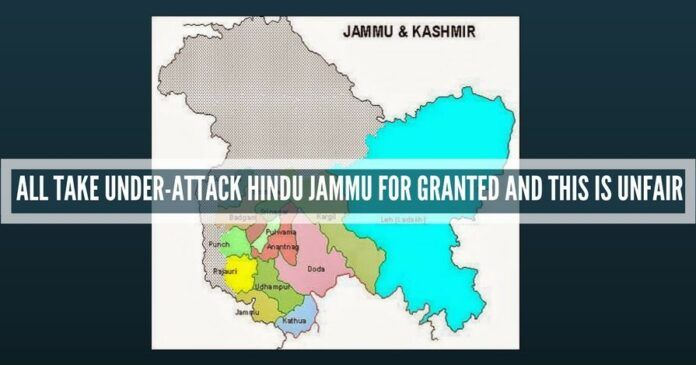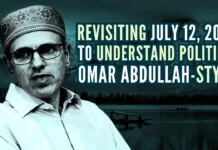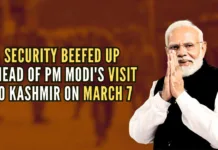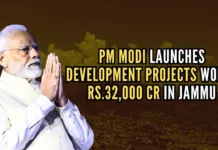
The people of Jammu province did not create any law and order problem, their demand was not considered
Jammu province and Ladakh in Jammu&Kashmir were perhaps the only regions in the country where people demanded a division of the State immediately after India attained independence. They demanded the reorganisation of the State on the ground that they despised the separatist and communal ideology of National Conference president and Emergency Administrator of Jammu&Kashmir, Sheikh Abdullah, and did not expect fairness from him.
In October 1989, people in Ladakh took recourse to violence on an unprecedented scale. Two persons died and several others got injured
In Jammu, the people, under the leadership of Balraj Madhok, who subsequently became president of the Bharatiya Jana Sangh, demanded a division of the State on November 1, 1947, six days after the State’s accession to India. The demand was supported by the BJS founder, Syama Prasad Mookerjee, in October 1949, when then Prime Minister Jawaharlal Nehru, at Sheikh Abdullah’s behest, granted special status to the State on purely religious grounds.
Mookerjee repeatedly said that the people of Jammu and Ladakh had the right to seek separation from Kashmir, as the Kashmiri leadership’s approach towards the country and Jammu&Kashmir was patently communal. In Ladakh, the Buddhists under the Head Lama, Kushak Bakula, raised the banner of revolt in November 1947 against Sheikh Abdullah and his administration. Bakula declared that the people of Ladakh did not want any truck with the separatist and communal Kashmiri leadership. They approached Nehru and urged him to merge Ladakh either with Jammu province or with Punjab or Himachal Pradesh.
The people of Jammu and Ladakh launched numerous struggles to achieve emancipation from Kashmir leadership between 1947 and 1987 but failed to achieve their stated goals. The Union Government, under the baneful influence of the Kashmiri leadership, rejected their demands as being ‘communal’ and against ‘national interest’.
The 1952 Delhi parleys between Jammu & Kashmir Wazir-e-Azam Sheikh Abdullah and Prime Minister Jawaharlal Nehru on the political future of Jammu & Kashmir; the 1975 Indira Gandhi-Sheikh Abdullah accord, and the 1987 Rajiv Gandhi-Farooq Abdullah accord prove one point: All these agreements were made to strike a deal with the Kashmiri leadership over the interests of the people of Jammu and Ladakh.
Things changed dramatically in 1989 when secessionist violence gripped Kashmir. The immediate fall-out was the loud clamour of Jammu for a separate State and for Union Territory status to Ladakh. The demands unambiguously pointed to the danger of being submerged under the rising clamour for ‘azadi’, plebiscite and the restoration of the pre-1953 politico-constitutional set-up or greater autonomy.
In October 1989, people in Ladakh took recourse to violence on an unprecedented scale. Two persons died and several others got injured. An alarmed Union Government had to yield and start parleys with the agitating Ladakhi leadership. The then Union Minister for Home Affairs Buta Singh persuaded them to give up their demand for Union Territory status and, offered them an Autonomous Hill Development Council instead. The Ladakhis accepted the proposal as a first step towards the final goal. Since the people of Jammu province did not create any law and order problem, their demand was not considered.
The Congress won 13 seats holding out a commitment that “If voted to power, shall amend the State Constitution to federalise the State’s polity and establish regional council
Convinced that New Delhi will not consider the demands of the people of Jammu Province, some prominent university teachers, advocates, businessmen and industrialists founded the Jammu Mukti Morcha on March 2, 1990, and launched a statehood movement with great verve. But weak leadership and conspiracies hatched by certain Jammu-based agents of Kashmiri leaders resulted in the JMM’s collapse, though the struggle for separation from Kashmir continued.
It was before the 2002 Assembly election in Jammu & Kashmir that the Rashtra Swayamsevak Sangh took a concrete step by adopting a resolution at its Kurukshetra annual meet, directing its State unit to establish the Jammu State Morcha and contest Assembly elections in alliance with the Bharatiya Janata Party. The JSM and the BJP contested the election on the statehood and reorganisation plank respectively. Together they won nine seats out of 37 in Jammu province. They would have won more than 25 seats, had Congress and the Jammu & Kashmir National Panthers Party not contested the election on purely Jammu-specific planks.
The Congress hoodwinked the Jammu electorate by holding out two categorical commitments — chief ministership for Jammu and adequately-empowered regional development board — and won 15 seats. JKNPP contested on the slogan of reorganisation and for the first time won four seats. Two independent candidates also won the election on statehood plank and later became associated members of the Congress to become Ministers.
In other words, the BJP, JSM, Congress, JKNPP and independent candidates won as many as 30 seats in the name of Jammu. The Congress, the People’s Democratic Party and the JKNPP formed a coalition Government in November 2002 with the PDP president as Chief Minister but did not fulfil any of the promises.
In 2008, all these parties again contested the Assembly election invoking Jammu’s cause and won 29 seats. The Congress won 13 seats holding out a commitment that “If voted to power, shall amend the State Constitution to federalise the State’s polity and establish regional council”.
The JKNPP won three seats and the BJP for the first time won 11 seats on the plank of “political empowerment”. The Congress again became part of the coalition Government but ditched the people of Jammu to keep Kashmiri leaders in good humour. The demand of the people of Jammu province for a separate State is genuine, given that the Congress-backed Kashmiri leadership has reduced them to being a nonentity. The following instances demonstrate the level of discrimination against the people of Jammu. The Chief Minister is always from the Valley and from one particular religious sect. So is the leadership of major political parties like the Congress.
In 2014, the BJP created a history of sorts. It won 25 out of 37 seats from Jammu on three main planks: Hindu Chief Minister from Jammu, end of discriminatory policies against Jammu and redressal of the grievances of refugees from Pakistan, Pakistan-occupied-Jammu and Kashmir and from the Kashmir Valley – all Hindus and a few hundred Sikhs. Besides, it contested the assembly election against pro-self-rule PDP, pro-autonomy NC and pro-semi-autonomy Congress.
It was hoped that the remarkable success of the BJP would end the Jammu’s 67-year-old night of discontent and despair, but it was not to be. The BJP went against the Jammu’s mandate and entered into an alliance with the PDP on the latter’s terms and conditions. It not only handed over the office of Chief Minister to PDP for a full term of six years but also all the portfolios with patronage, political weight and funds. Some of these included Home, Finance, Planning, Revenue, Agriculture, Education, Tourism, Public Works, Public Distribution System, Social Welfare, Law and Parliamentary Affairs, Labour and Employment, Science and Technology, Information and Sports. But more than that, the BJP also agreed not to touch Article 370, under which the solitary State of Jammu and Kashmir enjoyed a special status, and resolve the so-called Kashmir issue as per the Vajpayee’s “Insaniyat, Jamhooriyat and Kashmiriyat” doctrine.
The BJP did all this much to the chagrin of the people of Jammu. Ever since then, the people of Jammu have been chaffing and seething with anger. They have been accusing the BJP 24X7 of “betraying them” and seeking a fair share in the governance of the state, but with no result. It’s the PDP which has to play all shots and dictating terms. The BJP is there in the government but only in name; it has only been following the diktats of the PDP.
Jammu returns two members to the Lok Sabha and 37 to the Assembly at the rate of one per 15.59 lakh voters and 84,270 voters, respectively. In contrast, Kashmir returns three members to the Lok Sabha and 46 members to the Assembly at the rate 9.61 lakh voters and 62,673 voters, respectively.
Jammu’s share in the Civil Secretariat is not even 15 percent and the number of Secretaries to the Government is negligible. The unemployment rate in Jammu is over 69 percent and in Kashmir less than 30 percent. Over-developed and highly prosperous Kashmir has 10 districts at the rate of one per 1585.3 sq km. Jammu has an equal number of districts but at the rate of one per 2629.3 sq km. The road density km/sq km in Kashmir in 2006 was 310.4 and in Jammu, it was 138.7.
The harsh reality is that Kashmir occupies almost all the higher and lucrative positions in the Government, be it revenue administration, the finance department, the police and judicial departments and political institutions
The State power plants produce a paltry 25 MW electricity in Jammu as against 335.36 MW produced in adjacent Kashmir. A person from Jammu working with the Public Health Engineering under the Community Participation Scheme gets a monthly wage of Rs 500, whereas his Kashmiri counterpart gets Rs 2,100. The share of Jammu’s youth in Kashmir-based technical and professional institutions is negligible. On the contrary, Kashmiri Muslim students are in great strength in similar Jammu-based institutions.
The harsh reality is that Kashmir occupies almost all the higher and lucrative positions in the Government, be it revenue administration, the finance department, the police and judicial departments and political institutions. The net result is widespread frustration and dissatisfaction. The demand in Jammu for Statehood needs to be viewed in this context. It should also be viewed in the context of politics Kashmiri Muslim leaders of all hue indulge in to strengthen their respective constituencies in Kashmir as well as their politics of competitive communalism and separatism and the manner in which certain elements in the establishment have been changing the demography of Jammu by settling Rohingya, Bangladeshis and others in and around Jammu City and at strategic locations.
- ‘Kashmir My core constituency’: Revisiting July 12, 2003 to understand politics, Omar Abdullah-style - March 15, 2024
- Total deviation from traditional approach: Seven takeaways from PM Modi’s March 7 Srinagar visit - March 9, 2024
- Status of political parties: Why is further J&K reorganization imperative? - March 1, 2024











Thanks, Champion and Malhar
Is BJP idiot or is their politics more important than Hindus?? Do you want the Hindus in Jammu to pick up weapons which probably now seems the only way to protect our motherland and if this happens this might culminate in nuclear war.
Yes… When Andhra- Telangana can be split, Chattisgarh-orissa can be split Jharkhand-bihar can be split… Why not Hindus be separated from the state which has kicked out kashmiri pandits out.
Why aren’t Hindus given minority status in 9 (I think so) states….
Why are they being treated differently even by BJP…. Whose main support is Hindus. How can they not look into their interests when they had so much hopes on voting them.
Those states which were divided didn’t have communal problems …. (Telangana could be Muslim dominated don’t know ) but when they were given an option, why not Jammu n Ladakh?
It’s high time bjp caters to the needs of the people who would always vote for them, unlike minorities who will never vote them.